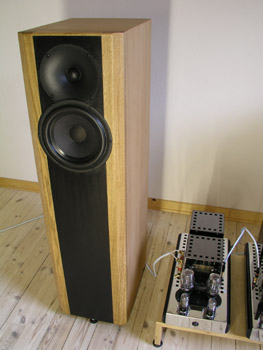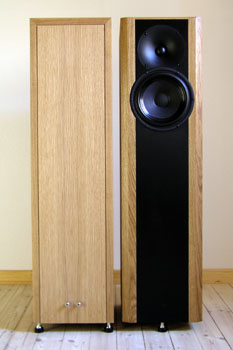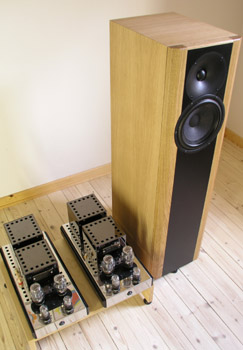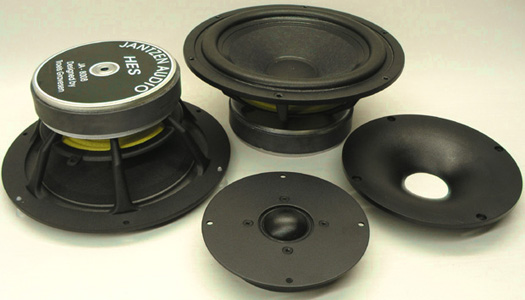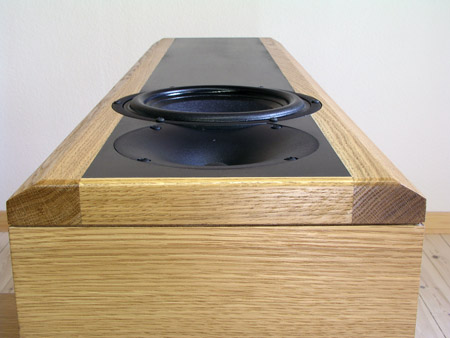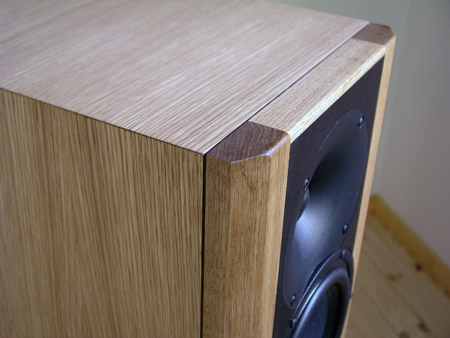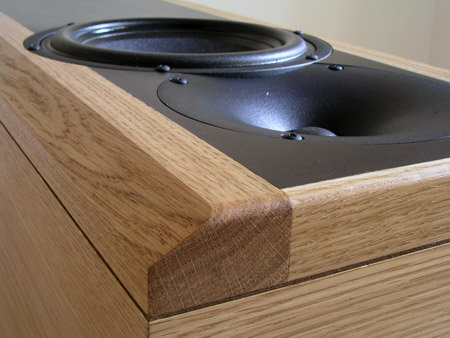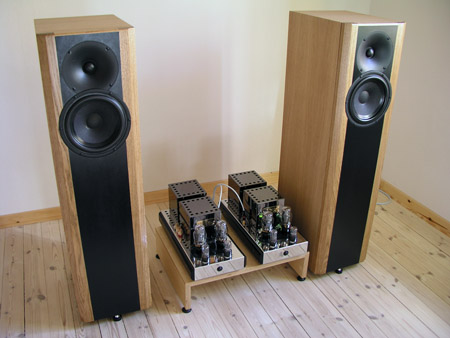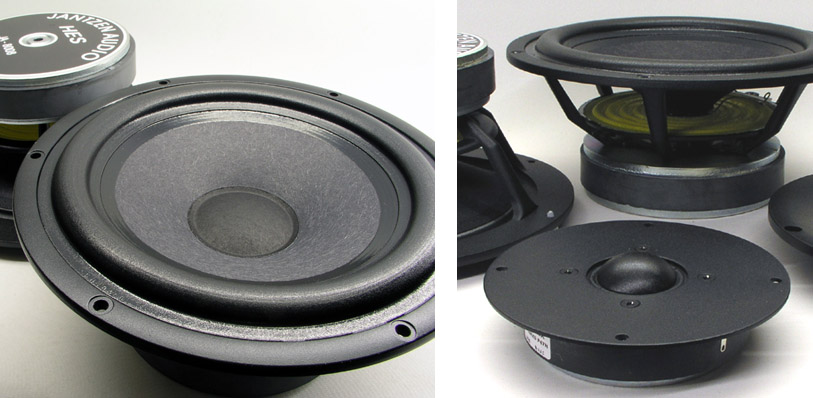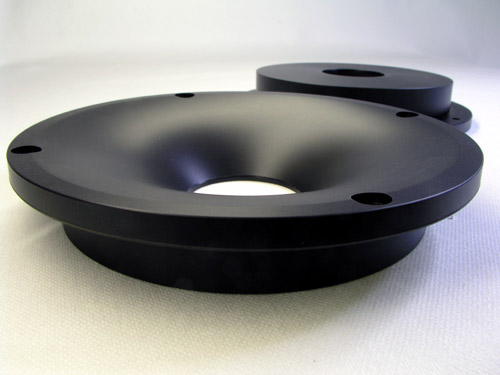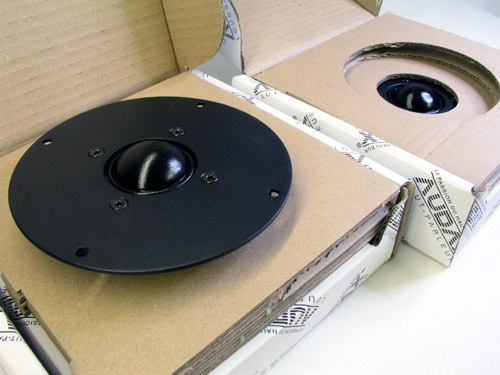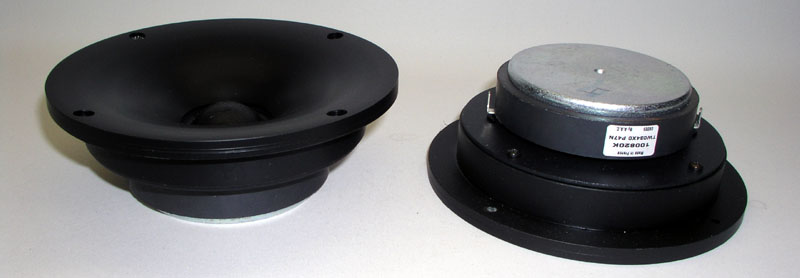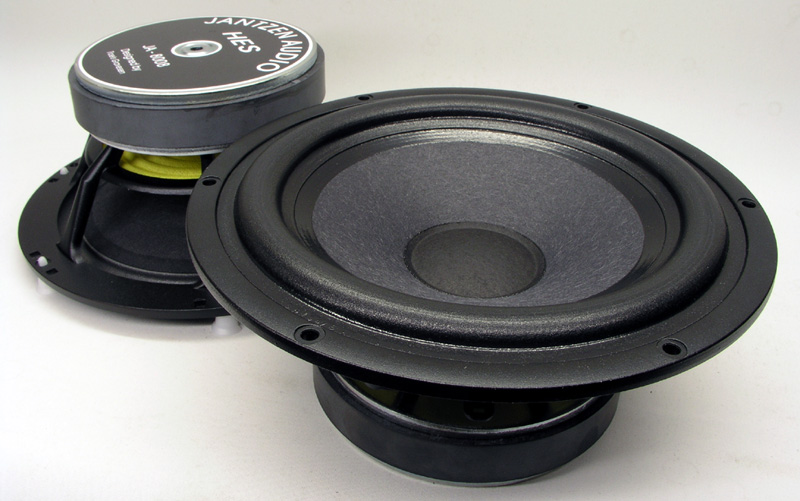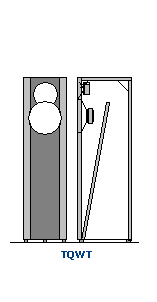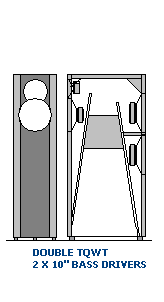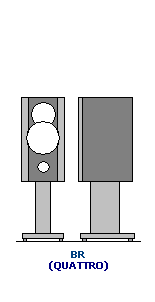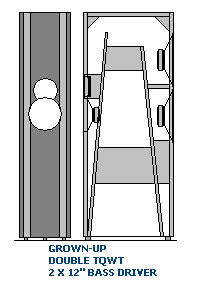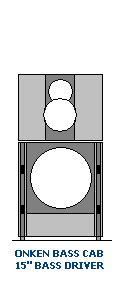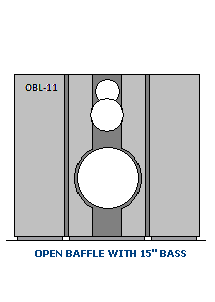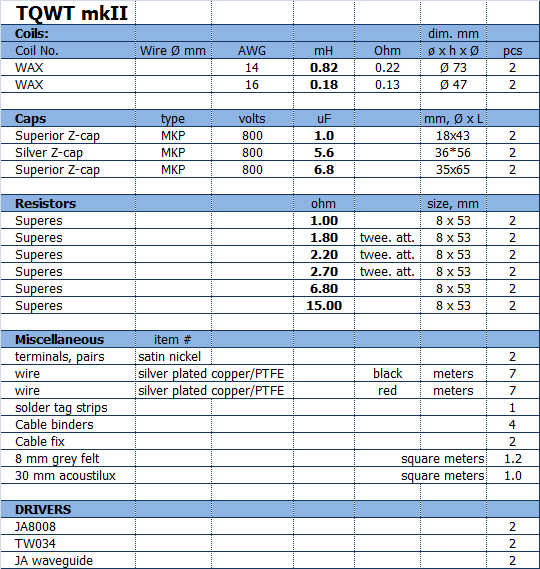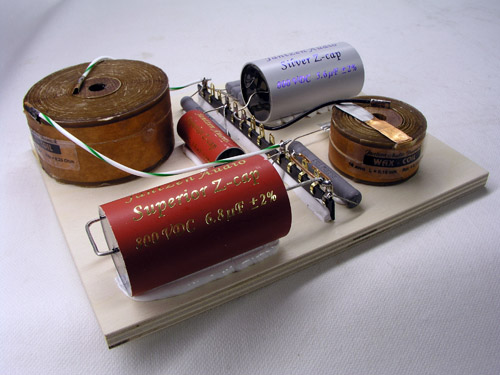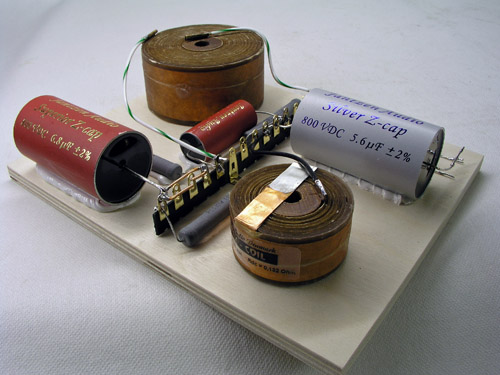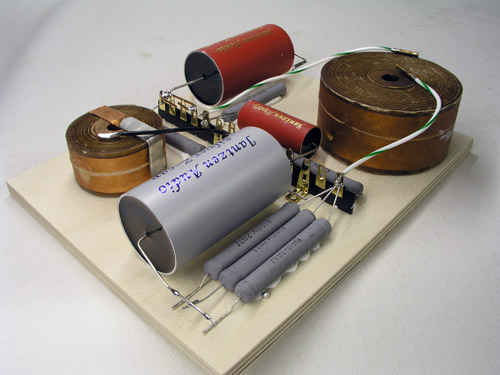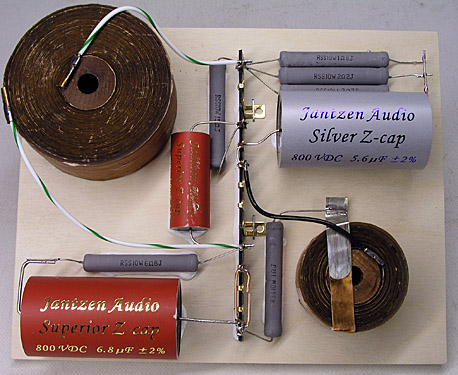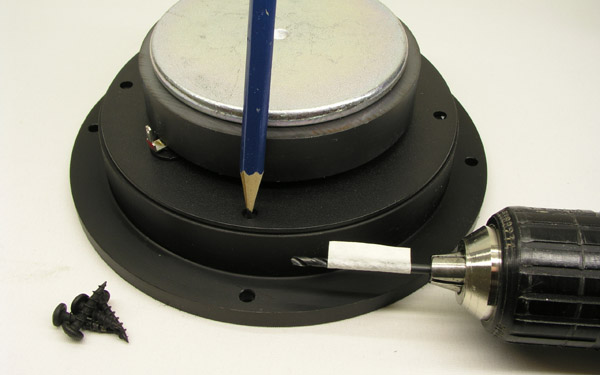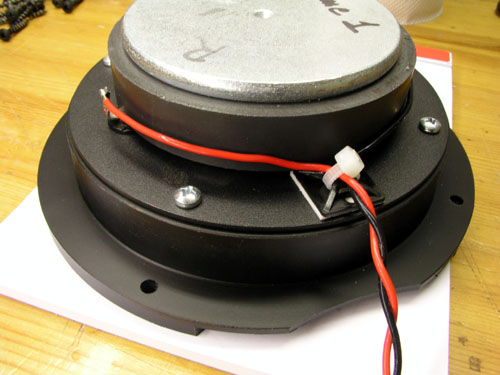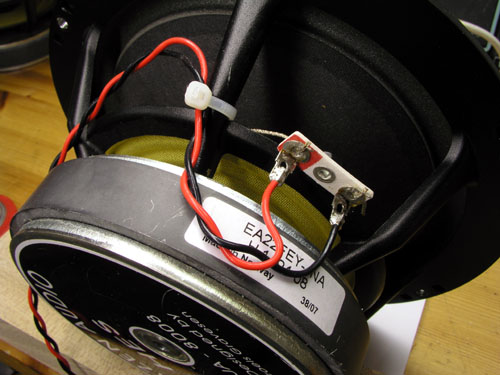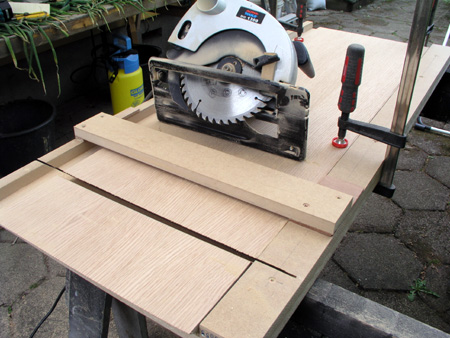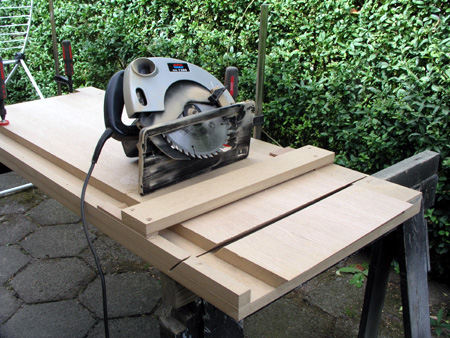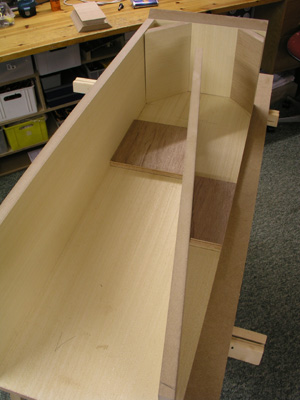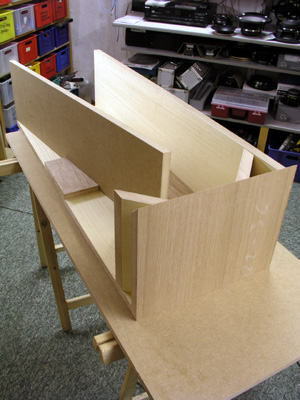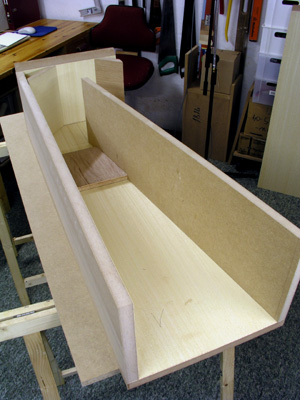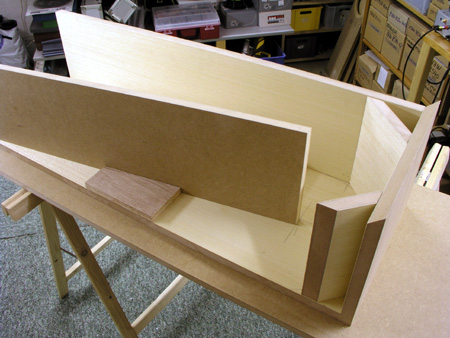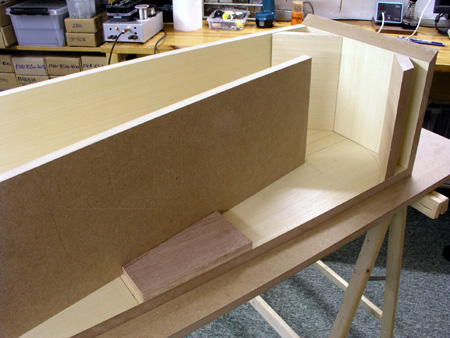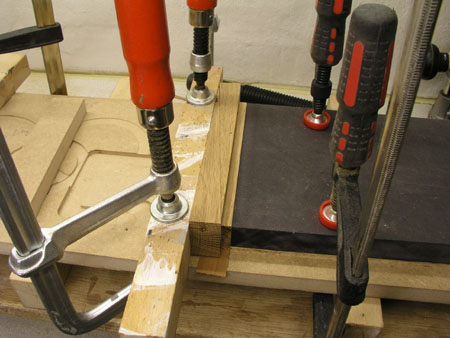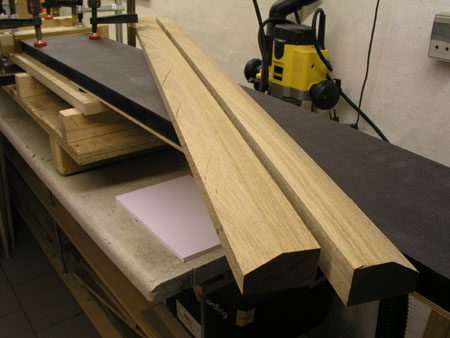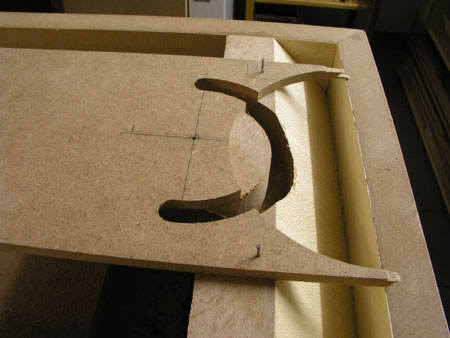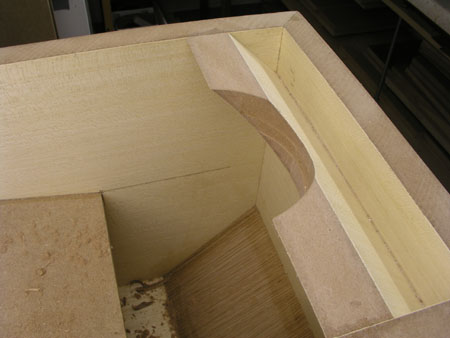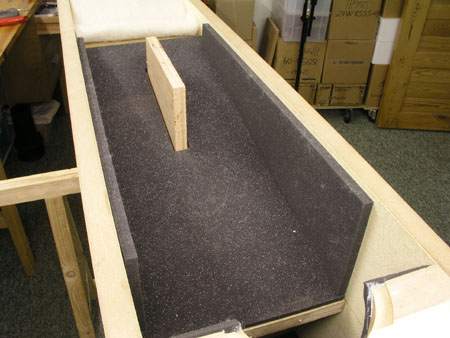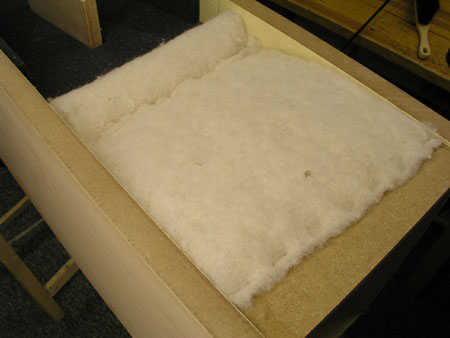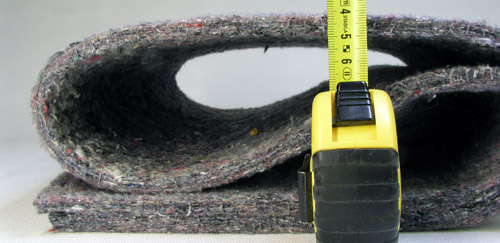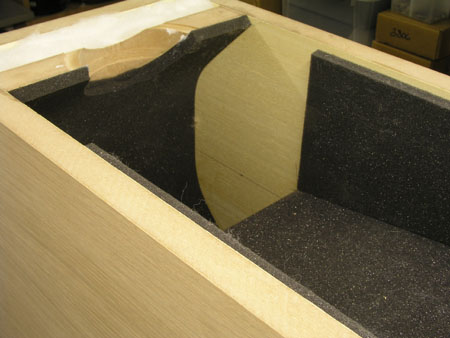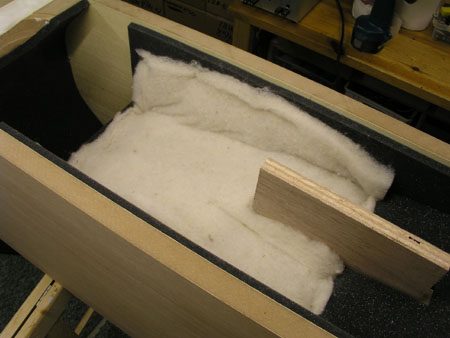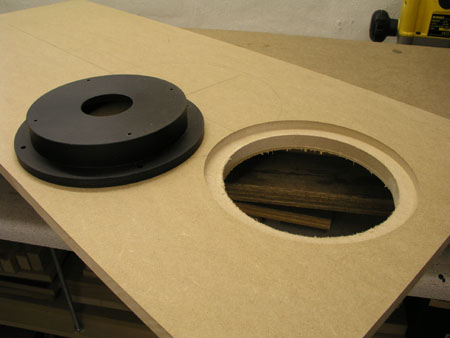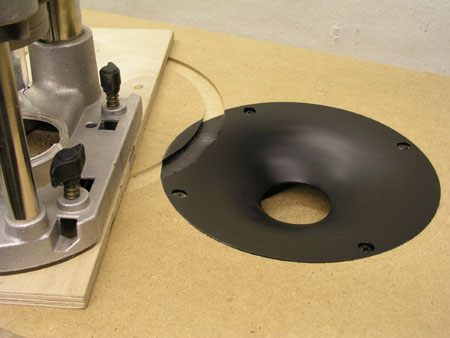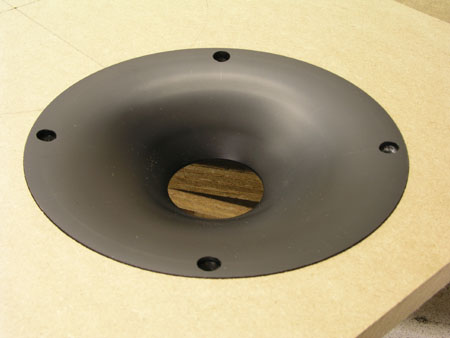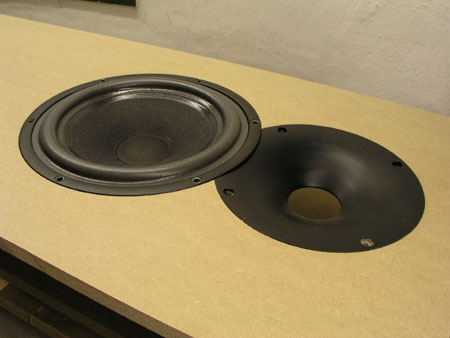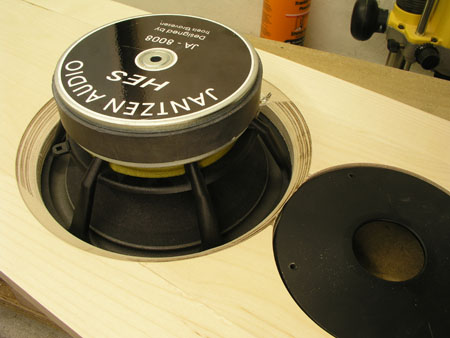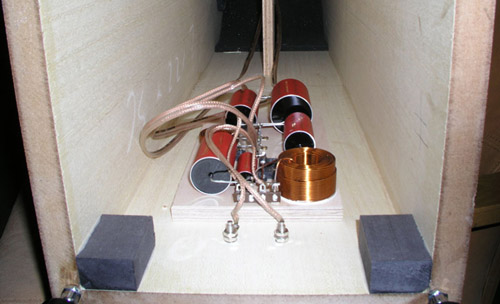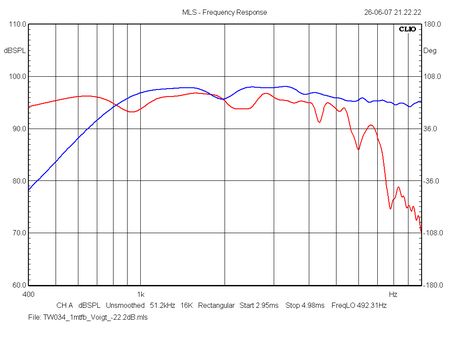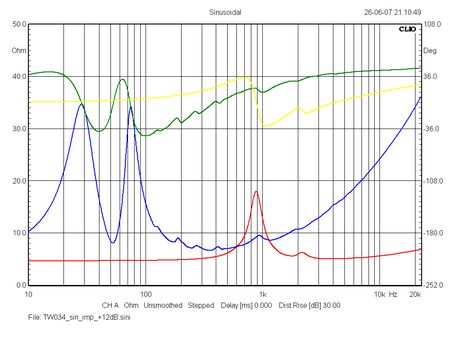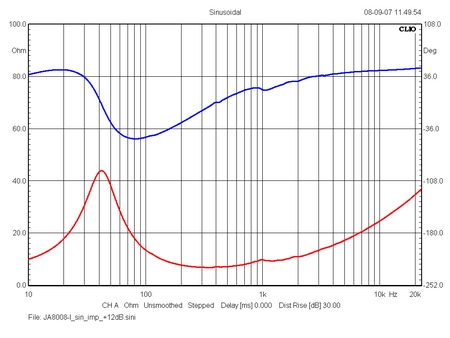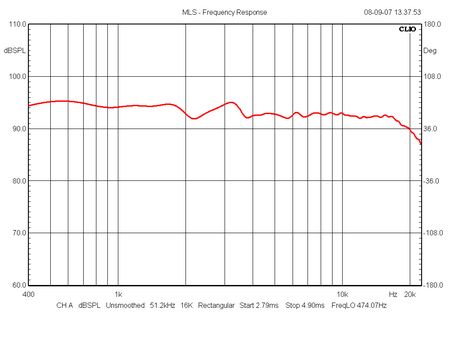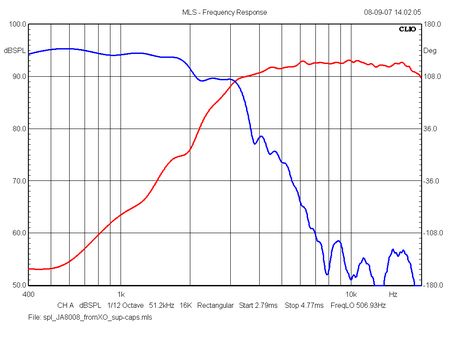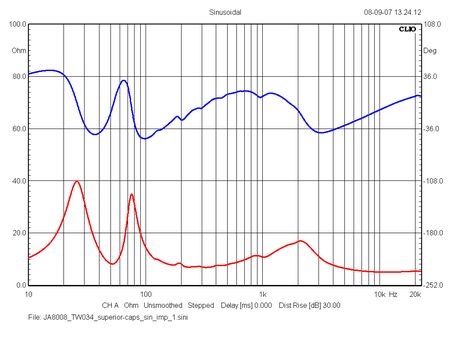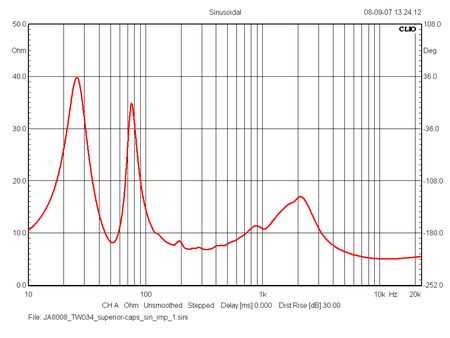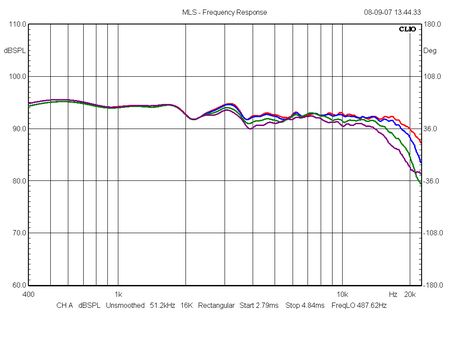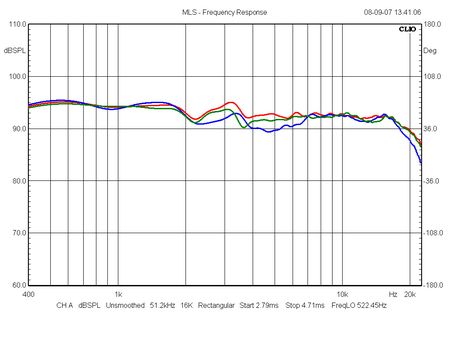TQWT-mkII
TQWT mkII replaced by new
TQWT mkIII JA8008 DRIVER MEASUREMENTS CROSSOVER TQWT CABS KIT-INFO 8008 Applications
For those having built the TQWT you may leave things as they are, or order 2 x three new components to fully upgrade. Read about the changes here. Read about the bigger brother, DTQWT speaker here. Also read about the new (2013) TQWT SEAS T35C002 option here. |
||
JA8008, the main driver Designing your own driver is a major challenge. Having worked with hundreds of different drivers, you eventually come to a point where you would like to design your own driver, hopefully fulfilling a wide range of desired features. Some people may think that cost is a major constraint here, but it is not, unless you want to use a lot of chrome, copper and fancy metal coatings; things that do not necessarily enhance sonic performance. Metal for the motor system, magnets, chassis, voice coils, cones and surrounds basically cost very little. The problem is to get the parts you want - and in the quantities you want. If you order 10,000 units, no problem. Smaller quantities are trouble. Obviously Jantzen Audio did not order thousands of units here, which would have been financial suicide. The driver presented here is not designed to be a commodity product, rather a carefully designed high-end product aimed at people enjoying low-wattage, high-class amplification, but it can obviously be connected to any high-quality system. Be prepared it will reveal possible deficiencies in the system driving the speakers. Be also prepared that it will urge you to use the best crossover components available like those seen below. Designing a driver is all about compromises! It's no problem increasing sensitivity 3, 6 or even 9 decibels. You cut down on membrane weight, increase magnet size, use low-mass suspensions, use short voice coils, etc. But there are prices to pay for each step you take. Thin cones = risk of cone break-up, increased colouration and lack of detail; short voice coil = low Xmax (reduced cone movement), large magnets = risk of frequency response steadily rising towards higher frequences, etc. Ideally we want our magnet system to accelerate our membrane instantaneously - but we need the poor thing to stop again - we need damping. I've experienced modern drivers where all measures were taken to increase acceleration and the result was severe peaking towards higher frequences, making crossover construction very difficult, and most unfortunate, the driver had severe ringing due to non-optimised suspensions, very noticeable on e.g. piano notes. The mechanical damping of any driver is extremely important and we have only two things at hand here: The spider and the surround. These devices have to keep the voice coil correctly in the magnet gap and the membrane centered correctly in the chassis. They must have the right elasticity to allow the membrane to move freely within Xmax and they must have correct resilience to quickly restore rest position when no voltage is applied, the latter not least important. The cone material, shape
and mass are obviously important parameters. From the
onset of the project there was no doubt in my mind that
it had to be paper. Paper cones have been around since Rice and Kellogg and it's another
wonder that wood pulp can me pressed into thin
curvilinear diaphragms, providing proper strength and
internal damping at the same time. Make them more rigid
and they may have nasty break-ups - or make them softer
and they'll compromise the ability to reveal details.
Quite some work went into the
dust cap. Should it be paper, fabric or a phase plug?
Should the dust caps be coated or non-coated, etc.? All
these possibilities were tried for measuring performance
and evaluated sonically by setting up the drivers in the
TQWT cabinet and listening to a wide range of music. Last
but not least a thick felt ring was added to the pole piece and this required SEAS to have special tools
made for punching out these felt pads. I wanted an 8" driver
that could handle 40-3000 Hz without severe cone
break-up, a sensitivity making 94-95 dB/2.8 volts in the
300-1500 Hz range and an 8 ohms voice coil, providing a
proper load for even single ended triode amplifiers. I
also wanted SEAS in Norway to make this driver due to
general excellent build quality, being Premium or EXCEL.
So, with help from Bjoern Idland at SEAS, the driver seen
here was constructed. The driver reaches 5.5 kHz, one
octave above intended point of crossover, and this
without noticeable peaking, allowing simple crossover
construction. I couldn't have asked for more. View
frequency response in measurement section. I've often found drivers
with foam surrounds superior in performance compared to
drivers with rubber surround. I've changed quite a few
drivers' surround from rubber to foam and always found an
increase in performance, generally a more vivid sound
without compromising the drivers' frequency response.
Sometimes the frequency response was even improved
although this often depended on proper coating of the
foam. Foam surrounds are very lossy and have very low
mass compared to rubber - even foamed rubber - and often
foam will provide 1-2 dB sensitivity increase. As a rule
of thumb, the main part of the total mechanical
resistance should come from the spider, not the surround
and the cone may bend from pushing towards the surround
being either too rigid or having high mass. This is in
particular important when we are dealing with lightweight
cones. Thus, we usually see high-efficiency drivers
having either foam or corrugated paper or fabric
surrounds, the latter usually coated to preserve the
fragile paper and for fabric to make them airtight. Break-in: As is often the case with high-efficiency drivers, the JA8008 takes some time to break-in before fully rendering its maximum performance, i.e. bass extension. After approx. 100 hours of use over a three-month period, Fs was reduced from 50 to 42 Hz. This from an average of 4 drivers under test. So, be patient after initial set-up.
I had a mail after finishing the TQWT construction and when I first read it, I thought the guy was kidding: "Would you please describe your feelings about JA8008 driver? It looks like you're writing much more emotional about vintage speakers and this driver is only "one from many" for you. Am I mistaken here?" My answer: The JA8008 is my blood, sweat and tears! My desert island speaker system! More than a year of dedicated work. It was my idea to lauch a high-efficiency 8" driver for low wattage valve amps, because there aren't that many around. This was definitely not just "another job" from Jantzen Audio. But I see you are right. I went through my files and I've been so busy telling about all the things going into making a driver and a speaker system, I've forgotten to write something about the system itself and how it performs. Like anything in life, we need emotion, feelings, enthusiasm, etc. I'll see if I can get it on paper. This is the worst part not falling into the ditch of stereotype self-praise - and despite the impossible task of describing sound. It really can't be done. You have to listen before you can know what this driver does. The "problem" with high-efficiency speakers (HES) is that people need to spend time reading - actually reading a lot of stuff - about what HES is, what they can do and what they sometimes cannot. People have to realise the relation between size, efficiency and low-end extension to make a qualified judgement of their needs before deciding what to buy. And we must realise that the companies offering 96 dB in a 40 litre cab do not tell these speakers do not play bass below 60 Hz. Thus my articles here: http://www.troelsgravesen.dk/HES.htm. The HES & HES-II articles are the pre-work going into the JA8008. In particular HES-II. The old SEAS CA21REX driver was the one that got it all started, and if you have a project ongoing for almost 1½ year, you simply cannot manage the constant level of the emotional exitement the writer misses. It doesn't work that way. There are times of trouble when it doesn't sound right and times of joy when things work out right. What I've tried here is
to make an overall balanced sound from the JA8008/TW034.
Compared to all other speakers I've made, the area where
this speaker differs the most is in its smooth midrange
and ability to reveal the dynamics of music. The speed
and attack it can produce is something none of all the
other speakers on this website can manage. It's fast and
a drum solo will kick butt, even from a 10 wpc amplifier. The aim of this project was to create a speaker system that could compete with high-efficiency 8" full-range drivers, but without the shortcomings of whizzer cones necessary in this category. I believe a properly engineered crossover offers significant advantages over the compromised dream of having a single diaphragm doing it all. And I think I've got it. There's no "midrange shout"; there's no 10 dB treble peaks you can't stand in the long run and there's an overall balanced presentation from the ever so important midrange, important for making instruments and vocals sound right. And there's an even power response over a wide area, something we can never accomplish from an 8" whizzer-cone fullrange driver. Robustness is another important parameter when putting bits and pieces together to make a driver. We often see commercial drivers made from components that really aren't sonically optimal, but durability is an important issue as the least thing a manufacturer wants to experience is his product being discussed for falling apart due to improper gluing, burned voice coils, etc., and having drivers back for re-coning is not something any manufacturer looks forward to. Ideally a driver should last for a couple of decades to fulfill customers expectation to quality and performance. Very few drivers can make 5 decades without suffuring from sagging cones due to loss of spider elasticity. The JBL 123A bass driver is probably the most durable driver I have ever experienced, but a wide range of vintage drivers really do not perform as they should due to age. High humidity and high temperatures are other problems to consider. Last but not least: Young people! Sorry young folks, but you have bad record for frying your voice coils Saturday evening. I have to include some comments on the large dome tweeter and not least the waveguide used for making an overall smooth transition from upper mid to lower treble. Having a large radiating area combined with a waveguide, providing both acoustic amplification, proper dispersion and reduction in distortion are all key elements in the smooth treble presentation. Treble os often regarded as "something above 3 kHz", which is really not true. It starts much earlier and proper integration of drivers is vital in any successful construction. Forget any other non-waveguide standard 1" dome tweeter for the JA8008. It's been tried and it doesn't reveal the potential of the JA8008 driver. Not even the most exotic and expensive tweeters could handle what this large dome can do. Tweeter for JA8008
Sourcing a tweeter to match a 95 dB driver was quite a problem, because there simply aren't many around. I didn't want to use horns and ribbons. Horns are too directional and ribbons have poor vertical dispersion and they didn't integrate well. Some recent Vifa, Peerless, ScanSpeak and SEAS tweeters have decent sensitivity, but rarely above 92 dB/2.8 volts. I didn't want a "naked" tweeter; I wanted a tweeter with a modest waveguide because they integrate better with the midrange due to reduced distortion at point of crossover and from providing an even power response. For a system tuned to 94-95 dB sensitivity we do not necessarily need an e.g. 95 dB/2.8V tweeter. Usually the crossover will raise the sensitivity a little, but still this isn't enough. Adding a waveguide to a
dome tweeter will - if well designed - raise sensitivity
4-6 dB in the 2-8 kHz range, but also lower on-axis
response above 10 kHz. Most 1" soft-dome tweeters
are fairly directional above 10 kHz and applying a
waveguide will often produce a more even power response,
hence reduce on-axis response above 10 kHz. The Dynaudio Esotar was tried, the Monacor DT300 + waveguide, Vifa XT25TG + waveguide, one of the new SEAS EXCEL tweeters, etc., but none of these were as good as the JBL LE26 + waveguide. Nor were the SEAS high-efficiency tweeters T29CF001/002. All very good tweeters in other combinations, but not here. Eventually the Audax TW034XO-P47N tweeter was tried and turned out to be just what I was looking for. A large 34 mm fabric dome driven by a huge 100 mm magnet. The TW034 is actually a classic, having been around for many years and well known from a range of former British studio monitors. Fortunately, Audax is still producing this tweeter, now in a new and improved version. The dome area is as big as the LE26 and integrates even better than the LE26 with the JA8008 driver. By coincidence, the waveguide will fit both options should you want to experiment. The waveguide was a new
problem, as no existing waveguide would fit the TW034
tweeter. Thus I had to engage a factory dealing with CNC
fabrication of everything that can possibly be made on a
lathe. A huge 180 mm diameter rod of black POM plastic is
stuck into the lathe and in a few minutes turned into
nice looking, solid waveguides. No need to fill cavities
here with damping material.
JA8008/TW034 applications
The JA8008/TW034 driver team has numerous applications as seen above. So far, all except the Onken have been realised. TQWT: This cabinet is the
one presented on this page. The system here is tuned to
~94-95 dB and provides sufficient bass for most
applications. Obviously a TQWT tower can be made as seen
in the second suggestion, providing a rather tall
construction, but with no bends to the tube. The DOUBLE TQWT was my second project and suitable bass drivers were found in the Eminence Deltalite II 2510 10" bass drivers. Minimum impedance can be maintained at 6 ohms from connecting bass drivers in series. What has been my prime target here is not having a high-pass filter on the front driver. The JA8008 takes decent cone excursion and supplemented by two 10" bass drivers the overall performance is enhanced compared to the TQWT. The price to pay for this is size. 150 litres brutto volume is what it takes - but what a sound! The BR is realised in the QUATTRO project, featuring a 40 liter vented cabinet and an 8 ohms minimum impedance due to the special crossover that enables us to use the low-Qt JA8008 driver in small enclosures. OPEN BAFFLE OB9: The JA8008/TW034 was tried on an open baffle, supplemented by a high-efficiency 15" driver and performs excellent - the best live-feeling in our living room yet. Usually we would use a high-Qt driver for a single-driver/open baffle set-up. I chose to use a fairly low-Qt driver, Eminence DeltaLite II 2515, by adding a baffle-step compensation circuit, increasing Qt and reducing sensitivity (99.2 dB) to match the 8008/TW034 combo (~94 dB on an open baffle). Initially an electronic crossover was used but next version will be passive and be launched 2011. The OBL-11. OPEN BAFFLE 11 is
finished and can be viewed here. This features a
passive solution to the crossover between bass and mid.
This is my homage to Mr. Gilbert Briggs, founder of
Wharfedale loudspeakers and his famous SFB, Sand Filled
Baffle, loudspeaker. DTQWT-12 was on the drawing board and the ink was hardly dry before an Italian guy took the bait and realised the project. Can be seen here. Be prepared for 152 cm height, 33 cm width and 60 cm depth. 2 x 12" bass drivers will load the large horn and deliver effortless deep bass performance. This project has been postponed over and over again due to lack of time - and not least, where am I going to put these huge cabs once made? Our house is too small for having big speaker systems in every corner. Construction page here. The ONKEN sketch is showing a well-know application, utilising a 12-15"/95-96 dB bass driver in a 80-160 litres cabinet with vertical front vents. The JA8008/TW034 is on top in either a vented box, a closed box or an open baffle as is often seen. Due to the high efficiency of the JA8008/TW034 duo, the use of electronic crossovers may be worth pursuing here with a point of crossover from 100-250 Hz depending on actual driver set-up. If Eminence DeltaLite 2515 is used as in OB9 and OB11, the passive crossover from OBL-11 is likely to fit in well here. What the JA8008 history already has told is the importance of having an extended range driver with a excellent midrange reproduction. Around the JA8008 driver, numerous constructions can be made to suit your room, your taste in cabinet design and overall bass requirements. Crossover for
TQWT-mkII
Changing your mkI crossover to mkII, download image here.
All kit parts supplied by Jantzen
Audio. All technical questions at: troels.gravesen@hotmail.com The Finished Crossover
TQWT Cabinet for
JA8008 As discussed in detail in the HES article, the price for high efficiency plus low-end extension is size. However, the choice of driver size and basic parameters for the JA8008 allows a modest cabinet size; that is if you think 80 net litres is a fair price to pay for 94-95 dB sensitivity and 40-45 Hz bass extension. We are not going to claim 98 dB sensitivity and 25 Hz bass extension from an e.g. 55 liter cabinet like some manufactures will do, because it doesn't exist. The JA8008 performs very well in a TQWT cabinet with a modest front baffle width of 280 mm. Height is 1050 mm and depth is 380 mm. Cabinet construction is simplicity itself as can be seen from the drawing below. Front panel is 30 mm MDF and slightly chamfered. Side, top and rear panels are 22 mm MDF and the internal panel is 19 mm MDF, supported by braces between front and rear panel. Cabinet drawing Construction details
Routing for the waveguide
Placement of crossover
Left: The un-smoothed
response of individual drivers in TQWT cabinet without
crossover attached, here from 400-10,000 Hz - the area
most important. As can be seen, there's a huge overlap
from both drivers around point of crossover ensuring
proper performance in areas where both drivers are
operating.
Left:
Summed reponse of drivers driven from crossover. Average
midrange sensitivity is 94-95 dB/2.8 V.
|
